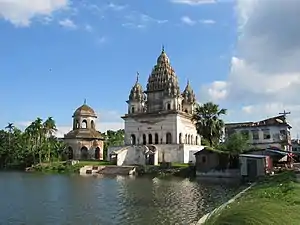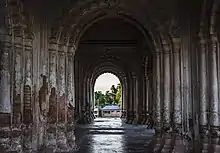.jpg.webp)


Pancha Ratna Shiva Temple, also known as Bhubaneswar Shiva Mandir, is a Hindu temple of the Puthia Temple Complex in Puthia Upazila, Rajshahi Division, Bangladesh. It is the largest Shiva temple in Bangladesh. The shrine overlooks the Shiv Sagar (Shiva's lake) to its left. The temple is well decorated in pancharatna (five spires) architectural style and is located at the entrance of the Puthia Rajbari.[1][2] Among the surviving Hindu temples, this shrine is said to be "an exceptional and more attractive for its architectural beauty" in Bangladesh.[1]
The temple is in Puthia town which is 32 kilometres (20 mi) away by road from Rajshahi city;[3] the city is also a rail head and is on the Dhaka-Rajashahi Highway.[2]
History
The temple's construction is attributed to Rani Bhuban Mayi Devi, the widow of Raja Jagat Narayan Ray of the five-anna estate.[4] It was built between 1823 and 1830 at an estimated cost of three million taka.[1]
Features

The lofty temple is unlike the terracotta plaster style decorations of the Govinda temple as it has a plaster finish. It is built over a raised platform of 11.66 feet (3.55 m) height, and its towers have beehive type design.[1][4] Built in brick masonry, in plan it is 65 feet (20 m) square,[1] with "north Indian type turrets and plastered finish".[3] The central sanctum is the only chamber of the temple which is 13.25 feet (4.04 m) square. A Shiva Linga, carved from black basalt stone is deified in the sanctum; it is the largest in the country. The central chamber is enclosed within a passage that runs on all four sides. The passage has cusp arched entrances from four sides. The temple tower consists of five decorated spires. The internal and external plastered walls of the temple are decorated with panels with themes from Hindu mythology. The raised platform of the temple is accessed through two brick built stairways, one from the north and the other from the southern direction.[1]
It is decorated with stone carvings and sculptural works, which were disfigured during the Bangladesh Liberation War in 1971. The invading Pakistani army attempted to displace and break the Shiva Linga, but were unable to move it from its position. The temple is now a protected monument.[5]
The corridors have a touch of Jaipuri architecture.
See also
References
- 1 2 3 4 5 6 "Puthia Rajbari". Pancha Ratna Shiva Temple. Rajshahi University Web Page. Archived from the original on 18 May 2015. Retrieved 12 May 2015.
- 1 2 Mikey Leung; Belinda Meggitt (2009). Bangladesh. Bradt Travel Guides. p. 301. ISBN 978-1-84162-293-4.
- 1 2 Alam, Mahmamuda, Puthia temple complex: Developing tourism through architecture (PDF), BRAC University, retrieved 11 May 2015
- 1 2 Bangladesh. Ministry of Cabinet Affairs. Establishment Division; Muhammad Ishaq (1976). Bangladesh District Gazetteers: Rajshahi 1976. Bangladesh Government Press. p. 72.
- ↑ McAdam, Marika. (2004) Lonely Planet's Bangladesh. pp. 114-115.
